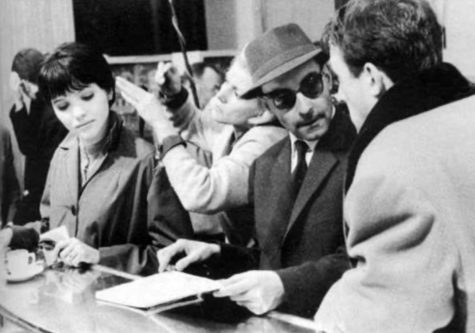The Plot Twist
Movies that make me think are arguably the ones that have had a bigger impact on my life. Many films I see pass through the windows of my soul for pure entertainment reasons — I probably got bored on a lazy Sunday morning and, instead of studying for an upcoming summative, I sit and watch something like The Departed or The Talented Mr. Ripley. I don’t mean that I don’t find the work of Scorsese or Minghella worthy of my time; quite the opposite, I value them more than my study time. However, these films don’t make me think. I can think about them, sure, but nothing more than that. And I will spend my time thinking about them too, undoubtedly. Nonetheless, the ones that simply make me think… Those are the ones that, like I previously mentioned, have an impact on my life.
At this point, the difference between “think” and “think about” may still be a bit unclear. I’ll give you an example. Pulp Fiction, one of my favorite movies of all time, just makes me think about it. I’ll think about that memorable dialogue, I’ll think about the violence, the colors, the confusing timeline, and the intertwined stories any old day of the week. I’ll even quote the film on a weekly basis, to say the least. However, what message did I get from it? The importance of foot massages? To shoot first, ask questions later? All of these messages are virtually useless to me unless my life was to one day depend on the meaning of a certain Bible passage. After all, the movie is just made to entertain. And it works for that! But it doesn’t make me think. And, in essence, that is what I want from a film.
On the other hand, movies that make me think — the ones that I ponder and reflect on, the ones that I am able to extract a meaningful idea from — are just a bit rarer. There is an abundance of them, to be sure. The Clockwork Orange, for instance, made me think about a variety of different things: what is redemption, and can it be achieved? Is the system even constructed for us to be able to get back up if we fall? And why on Earth is it even called The Clockwork Orange?! (I later figured out it was because the main character, Alex DeLarge, a human — something organic and natural, like a fruit — was being “fixed” like a broken machine, making him the clockwork orange.)
And, while The Clockwork Orange is a lovely example of a film that makes me think, there is a small and narrow subsection of these movies that are even more gratifying to view. And it’s all because of a little thing they all have in common: the Plot Twist.
When I refer to the Plot Twist, please do not misinterpret me. I do not mean a typical, oh-my-god-she-ended-up-with-him Plot Twist. If there was a better term for this specific tactic, I would use it — however, the dictionary is not on my side on this one. (Although “surprise ending” could be used to refer to some of these, it would not be fair to call all of them that since some Plot Twists occur smack in the middle — and “surprise middle” just doesn’t have the same nice ring as other terms.) The Plot Twist I am alluding to does not have to do with silly unexpected turns a story takes. As a matter of fact, in my book, it can only mean one thing; and it can slightly vary between films, depending on the course the director wants it to take.
Imagine you are watching a movie. You are being presented with events, conversations, characters, and places that you deem as true. They are a part of the story, and you believe that. Because you are expected to. And, suddenly, it is revealed that it is all fake. A figment, perhaps, of a character’s imagination, or maybe a sort of “imaginary friend” that we all thought was just as real as any other person in the film. Maybe our main character is actually dead, and, all this time, he’s been roaming around the setting of the movie just like any other normal character.
To make this point even clearer, I’ll introduce my top four favorite movies with this signature Plot Twist. And, reader, beware: there are spoilers ahead. If you plan on watching any of these, do yourself a favor and refrain from reading on, for the element of surprise will be taken away from the viewing experience, and will therefore make the film that less good.
- Dolor y gloria, by Pedro Almodóvar (2019)
Dolor y gloria is Pedro Almodóvar’s most intimate film yet, telling the story of how disease trickles into the life of filmmaker Salvador Mallo (Almodóvar’s alter-ego) and interrupts his career. Throughout the film, the topics of fiscal deterioration, disease, death, drugs, homosexuality, and the remembrance of the past (among others) are explored with intrigue and beauty. The film bounces back and forth between Mallo’s present and past — his present self being interpreted marvelously by Antonio Banderas; his younger self by Asier Flores. Throughout the movie, we see how his childhood has affected his present self as he struggles and grasps creative inspiration. After many twists and turns (in both his adult and childhood), we reach the final scene. The audience seems to watch a scene from his childhood that has already been played in the movie. It’s a lovely, aesthetically-pleasing set, filled with warm, orange hues. As we see young Mallo ask his mom if there will be a movie theater in the place they are moving to, the panning out of the camera reveals something even more important than what is going on between the characters. We see a sound technician holding a microphone over their heads, and, later on, a lady coming on screen with a clapperboard as we hear the word “cut!” coming from somewhere off-screen. It is here, in this last, oh-so-important scene, that we realize that the audience wasn’t really being transported from Salvador Mallos’ childhood to his present, but rather jumping from his new autobiographical movie to his real life.
The way Almodóvar led his audience through a journey of discovery was sincerely perfect. This Plot Twist does not only add shock value to the film, but it makes one realize that the inspiration that Salvador Mallo needed all along was already a part of him. We all have inspiration inside of us, an inspiration that the world wants to hear, to see. Looking for it elsewhere — particularly in drugs and harmful substances, like Mallo did do — is not necessary. Many great artists (especially musicians in the 60s) did use their fair share of such substances to enhance their creativity; however, just like Salvador Mallo, creating something of value cannot be possible without first looking into who you are. And, just like that, Almodóvar created a more than insightful film — a work of art — that makes his audience think.
- The Sixth Sense, by M. Night Shyamalan (1999)
This film by M. Night Shyamalan stars Bruce Willis as a child psychologist, Malcome Crowe, who is challenged by a patient who can apparently talk to the dead. The opening scene reveals Malcolm being shot one night in his home by an intruder (who was himself a past patient of his and thought that he was incorrectly treated). After shooting Crowe, he turned the gun on himself and pulled the trigger. Despite this attack, we see Crowe again “the next fall,” thanks to the handy subtitles let us know, as he takes on a new case. This boy, Cole Sear (Haley Joel Olsment), can allegedly talk to the dead and see ghosts. Wanting to redeem himself after the failed treatment of the patient who shot him, Crowe takes his case. After many things happen, like Crowe’s problems with his wife (who does not seem to be listening to him), and Cole’s many ghost sightings, we reach the end of the movie. We see Crowe’s wife, Anna, talking in her sleep, asking why Malcolm left her. Here, the psychologist recalls something Cole said: dead people only see what they want to see. The audience sees Malcolm remember the night he was shot — which, in reality, was also the night he died. Throughout the movie, Cole was speaking to his dead psychologist, and thanks to the words that he spoke, Crowe understands what his unfinished business is. After telling his wife he loves her and that she was never in second place, his soul vanishes in a white flash of light. The puzzle pieces fall into place, and the audience understands everything, even before this big reveal, there was nothing the viewers didn’t understand, at least to the extent we believed it was natural to have doubt.
Night Shyamalan’s perfect Plot Twist in The Sixth Sense invites us, the viewers, to think about our unfinished business and to understand that it’s better to move on than to stay stuck in a loop of ignorance. It poses an interesting question to ponder on, too: is ignorance really bliss? When we die, would we want to know we’re dead? All these philosophical inquiries that Shyamalan is able to pose so intriguingly are thanks to that wonderful, heart-stopping Plot Twist in the end.
2. Fight Club, by David Fincher (1999)
This adaptation of Chuck Palahniuk’s novel of the same name follows the story of an unnamed insomniac office-job employee who is deeply unsatisfied with his life. After meeting Tyler Durden and creating an underground fight club as a sort of therapy for his dissatisfaction, the club starts taking a different direction. More fight clubs around the country are founded, and, ultimately, the groups stop being merely therapeutic and turns into an anticapitalist and anti-corporative organization called Project Mayhem. While Tyler’s friend (who is also the narrator) is greatly opposed to this change, especially because of his exclusion from the plan-making, Durden himself is all for it. At one point, Tyler disappears and, as the narrator goes on a search for him, he discovers that Tyler Durden is, in reality, a part of him, after being called “Tyler” by a fellow fight club member. He calls Marla, someone with whom he has a love-hate relationship (to say the least), who has been sleeping with Tyler throughout the film, and he finds out that, all this time, both of them had been together multiple times. Tyler Durden is the narrator. Once he is conscious of this fact, his other self explains that they are split personalities. Tyler Durden controlled the narrator’s body when he was asleep, explaining how things got so out of hand with the fight club all of a sudden.
The Plot Twist in Fight Club actually happens smack in the middle of it, keeping viewers on the edge of their seats for the remainder of the film. Later on, we see that Project Mayhem’s ultimate goal was to destroy buildings that contain the registers of credit card companies so that a great portion of the population’s debts are cleared. The narrator does not want this stunt against capitalism and corporate culture to happen, but Tyler ends up winning the internal fight, and in the final scene, we see Marla and Tyler holding hands as they watch the detonated explosives burning down buildings in slow motion as the Pixie’s “Where Is My Mind?” plays in the background. Not only does the film give its audience a great Plot Twist, but it also ends with an open-ended finale, allowing viewers to use their imaginations to fill in the gaps as to what would have happened next. (The series Mr. Robot, created by Sam Esmail, explores this further through the lens of Elliot Alderson, a brilliant, yet mentally unstable cybersecurity engineer, who wants to fix everything that is wrong with the world and its system through the one thing he knows how to do: hacking. I won’t reveal too much about this series, but I will say that it makes you think.)
My apologies for breaking the first and second rules of the club, but the social and systematic questions that the film poses are just too brilliant to be ignored. The movie explores mental instability and capitalism through two (or should I say one?) characters that encourage the audience to challenge the system while creating an atmosphere that, although dark and intense, is never lacking entertainment. Am I a slave to the system, too? Is there something I can do (other than starting an underground boxing club) to break free? Does the end justify the means? The big Plot Twist in the middle of the film pulled the trigger on the gun that ignited all those questions, questions that, after all, all of us should reflect upon.
- A Beautiful Mind, by Ron Howard (2001)
Ron Howard’s film follows the story of a genius mathematician, John Forbes Nash Jr., as he develops his career and wins a Nobel Prize. The story begins when Nash arrives in Princeton after receiving the grand Carnegie scholarship for mathematics. After meeting many fellow students, including his roommate, Charles, Nash feels pressured into finding an original idea to publish. One evening, he comes up with a genius dynamic that defies economic principles established a long time before. He reaches success and, years later, thanks to his prestigious reputation, he is invited to the Pentagon to decode enemy telecommunications, for he is an expert at solving such problems. He even meets a mysterious supervisor, William Parcher, who gives Nash the task of finding patterns in magazines and newspapers to uncover the Soviet’s secret agenda. As Nash becomes more obsessed with this, his paranoia of being discovered by unfriendly parties grows, eventually interrupting the normalcy of his life, which usually just was made of events like meeting his former roommate’s niece, Marcee, whom he ends up loving very much. As things start going in a downward spiral of uncertainty and fear of Soviet forces taking him out (since he was decoding their messages in the papers), Nash loses his calm one day as he gives a conference at Harvard University. He begins getting violent, as he believes he is being followed by secret agents, and he ends up having to be sedated. He wakes up in a psychiatric hospital, where the viewers find out that Marcee, Charles, and Parcher all only exist in his imagination. Throughout the remainder of the film, we see how Nash struggles to have a grasp on reality and to get a hold of his schizophrenia while balancing his beautiful mind’s genius and his home life.
What makes this movie so great is the fact that it is based on a true story.
Howard’s film reminds the audience that Plot Twists don’t only happen in fictional movies — they are also present in real-life as well. The Plot Twists we should be paying attention to should not only be limited to the ones found in the film, but to the ones we as humans experience on a day-to-day basis. What better example than this Coronavirus pandemic? One day, we felt like we were safe in the comfort of our homes, yet, suddenly, we took a 180-degree turn that affected (and continues affecting) virtually every single aspect of our lives. But, just like Nash in A Beautiful Mind, we must remember that these bumps in the road shouldn’t get in the way of a happy ending.
Your donation will support the student journalists of The Baldwin School of Puerto Rico. Your contribution will allow us to purchase equipment and cover our annual website hosting costs.

Hello, my name is Caridad Álvarez and I am this year’s editor-in-chief. I am in my senior year and I have been contributing to the Bullseye since ninth...









